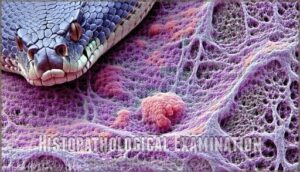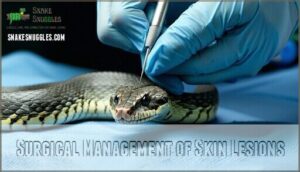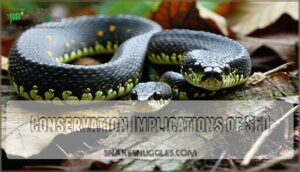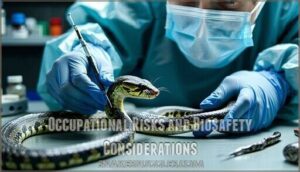This site is supported by our readers. We may earn a commission, at no cost to you, if you purchase through links.
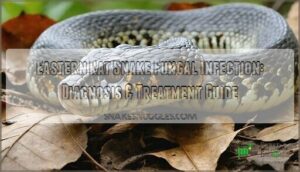
You’ll notice difficulty shedding, behavioral changes, and sometimes fatal complications if left untreated. The fungus thrives in contaminated environments and spreads through direct contact or infected habitats.
Early detection makes all the difference – successful treatment combines antifungal medications, surgical removal of lesions, and proper supportive care. Understanding the warning signs and treatment protocols can save your snake‘s life, emphasizing the importance of early detection.
Table Of Contents
- Key Takeaways
- Ophidiomycosis in Eastern Rat Snakes
- Diagnosis of SFD in Eastern Rat Snakes
- Treatment Approaches for SFD in Eastern Rat Snakes
- Environmental Factors and SFD Transmission
- Epidemiology and Prevalence of SFD
- Conservation Implications of SFD
- Advancements in SFD Research
- Collaboration and Partnerships for SFD Management
- Occupational Risks and Biosafety Considerations
- Future Directions and Research Priorities
- Frequently Asked Questions (FAQs)
- How to treat fungal infections in snakes?
- What are the symptoms of snake fungal disease?
- How to get rid of fungal infection on snake plant?
- Can humans get snake fungal disease?
- How do you treat a snake fungal infection?
- What does snake fungal disease look like?
- What is antifungal treatment for snakes?
- How does SFD affect the behavior of eastern rat snakes?
- Can eastern rat snakes pass SFD to other animals?
- Are certain age or sex groups more susceptible to SFD?
- Conclusion
Key Takeaways
- Watch for telltale signs – You’ll spot crusty lesions, cloudy eyes, and thick scaly patches on your snake’s skin that look like burned areas, plus behavioral changes like increased basking and loss of appetite.
- Act fast with professional treatment – You’ll need veterinary care combining antifungal medications, possible surgical removal of severe lesions, and supportive care including proper heat and nutrition for the best chance of recovery.
- Prevent spread through strict biosecurity – You’ll want to quarantine infected snakes immediately, disinfect all equipment between handling, and avoid moving contaminated soil or materials between habitats.
- Understand the serious threat – You’re dealing with a disease that kills 40% of infected snakes and spreads rapidly through environmental contamination, making early detection and prevention critical for snake populations.
Ophidiomycosis in Eastern Rat Snakes
If you’re dealing with an eastern rat snake showing unusual skin problems, you might be looking at ophidiomycosis—a serious fungal infection that’s spreading across North America.
This disease, caused by Ophidiomyces ophidiicola, creates crusty lesions and can seriously harm your snake’s health if left untreated, which makes it a significant concern for snake owners to be aware of Ophidiomyces ophidiicola.
This silent fungal killer lurks in soil, turning healthy snakes into walking casualties.
Identification of Ophidiomyces Ophiodiicola
Identifying Ophidiomyces ophiodiicola requires detective work using specialized laboratory techniques.
You’ll rely on culture techniques, microscopic analysis, and genetic markers to confirm this sneaky fungal pathogen.
Key identification methods include:
- Fungal morphology examination reveals powdery, whitish colonies with distinctive skunk-like odor
- Culture techniques on Sabouraud’s dextrose agar show slow-growing colonies at ideal 25°C temperature
- Microscopic analysis identifies narrow, septate hyphae and characteristic conidia dimensions (3-12.5μm long)
- Genetic markers through DNA sequencing of ITS regions provide definitive species confirmation
- Environmental detection methods help track this adaptable pathogen across diverse pH conditions.
The fungus causes distinct lesions on infected snakes.
Pathogenesis and Progression of SFD Infection
During infection, Ophidiomyces ophiodiicola begins its fungal invasion by penetrating the snake’s skin barrier, triggering an immune response that unfortunately can’t keep pace with the pathogen’s aggressive spread.
This fungus outpaces the snake’s natural defenses, spreading faster than immunity can respond.
The pathogenesis involves progressive lesion development that starts as localized scabs but can advance to severe systemic effects throughout the body.
You’ll observe clinical signs that worsen as disease severity increases – from initial skin thickening to disfiguring facial lesions that can impair feeding and breathing.
The infection disrupts normal molting cycles, creating abnormal shedding patterns that further compromise the snake’s health.
- Tissue penetration: SFD in snakes involves fungal hyphae breaking through healthy skin, causing inflammation and crusty lesions that spread outward
- Behavioral changes: Infected snakes often increase basking time and may refuse food, weakening their overall condition and survival prospects
- Cascade effects: Snake fungal disease creates a domino effect where skin damage leads to secondary infections and physiological stress
Diagnosis of SFD in Eastern Rat Snakes
When you suspect SFD in an eastern rat snake, accurate diagnosis requires specific laboratory tests to confirm the presence of Ophidiomyces ophidiicola.
You’ll need to collect proper tissue samples and work with a veterinary lab that can perform culture, PCR testing, and histopathological examination to distinguish SFD from other skin conditions, which is crucial for a accurate diagnosis.
Laboratory Confirmation Methods
Once you’ve spotted those telltale crusty lesions, confirming SFD requires lab work.
Fungal culture grows Ophidiomyces ophiodiicola on special media, while PCR testing detects fungal DNA with impressive accuracy.
Histopathology examines tissue samples under microscopes, and DNA sequencing identifies specific strains.
Sample collection through swabbing or biopsies feeds these molecular diagnostics, giving you definitive answers about your snake’s condition.
For less invasive sampling, swabs show promise compared to biopsies.
Histopathological Examination
Microscopic examination reveals what’s happening beneath your eastern rat snake’s skin when Snake Fungal Disease strikes.
Histopathological examination of tissue sampling provides definitive diagnostic accuracy for fungal identification.
- Lesion morphology shows characteristic tissue architecture changes
- Cellular changes reveal inflammatory responses and tissue damage
- Fungal hyphae become visible within infected skin layers
- Snake pathology experts can distinguish SFD from other conditions
- Reptile pathology analysis confirms Ophidiomyces ophiodiicola presence
Molecular Diagnostic Techniques
While tissue examination reveals structural changes, molecular diagnostics offer the gold standard for identifying snake fungal pathogens.
These DNA-based techniques provide unmatched PCR sensitivity and qPCR specificity when detecting Ophidiomyces ophiodiicola. You’ll find genetic sequencing particularly valuable for strain identification and confirming your diagnosis beyond doubt.
The disease is caused by Ophidiomyces ophiodiicola fungus.
Modern molecular diagnostics transform SFD detection through:
- Lightning-fast results – Skip the waiting game with rapid PCR testing
- Rock-solid accuracy – Eliminate guesswork with definitive genetic evidence
- Future-proof methods – Access cutting-edge metagenomic analysis for thorough pathogen screening
These fungal diagnostics don’t just identify the culprit—they reveal exactly which genetic variant you’re dealing with, helping you choose the most effective treatment approach.
Treatment Approaches for SFD in Eastern Rat Snakes
When you’re dealing with SFD in eastern rat snakes, treatment becomes a multi-pronged approach that combines medical intervention with careful supportive care.
You’ll need to tackle everything from surgical removal of severe lesions to antifungal medications, though success rates vary substantially depending on how advanced the infection has become, which requires a careful and supportive approach.
Surgical Management of Skin Lesions
When surgical treatment becomes necessary, your snake veterinarian will perform lesion excision and debridement methods to remove infected tissue from your eastern rat snake.
The procedure involves carefully cutting away damaged skin while preserving healthy tissue. Grafting techniques may be considered for extensive wounds.
Specialized instruments, such as snake surgical tools, are essential for these delicate procedures.
Post-operative care requires strict infection control protocols, including wound monitoring and proper environmental management to prevent recontamination during recovery, ensuring a smooth healing process with proper environmental management.
Antifungal Medication Trials
While surgical approaches address visible lesions, antifungal medications represent the pharmaceutical front in fighting snake fungal disease.
You’ll find researchers testing various treatments despite mixed results in colubrid snakes like eastern rat snakes.
Current antifungal medication trials focus on:
- Terbinafine nebulization – Shows promise but requires multiple treatment courses over months
- Triazole antifungals (voriconazole, itraconazole) – Face dosage optimization challenges and safety concerns
- Combination therapies – Exploring multiple drug approaches to improve treatment duration effectiveness
- Resistance development monitoring – Tracking how pathogens adapt to prolonged antifungal exposure
Drug efficacy remains inconsistent, with only 29% of treated snakes achieving molecular resolution after extended nebulization protocols.
Some suppliers offer nebulization snake products for this purpose.
Supportive Care and Rehabilitation
While antifungals battle the fungus directly, supportive care provides the foundation your snake needs to fight back.
Think of it as creating a healing sanctuary that boosts their natural defenses.
Thermal Support maintains ideal temperatures for immune function—usually 78-85°F for Eastern rat snakes.
Fluid Therapy prevents dehydration through soaking dishes or gentle misting.
Nutritional Plans focus on easily digestible prey to maintain body condition during treatment.
Wound Management keeps lesions clean and monitored for secondary infections.
Stress Reduction through quiet environments and minimal handling accelerates rehabilitation.
This thorough supportive care approach, combined with antifungals, substantially improves snake fungal treatment outcomes and long-term recovery success.
Environmental Factors and SFD Transmission
Understanding how SFD spreads through your snake’s environment is essential for effective prevention and management strategies.
The fungus Ophidiomyces ophidiicola thrives in soil and can persist across various environmental conditions, making transmission prevention particularly challenging for wildlife managers and captive snake owners alike, which highlights the importance of effective prevention.
Role of Contaminated Soil and Habitat
Soil contamination creates environmental reservoirs where fungal pathogens thrive, making transmission nearly inevitable.
You’ll find Ophidiomyces ophiodiicola persisting in contaminated soil around snake hibernacula, displaying remarkable fungal persistence across various pH levels and moisture conditions.
These dirty environments become hotspots for environmental transmission, especially in damp environments where the fungus flourishes, creating ongoing habitat degradation risks.
The disease is caused by Ophidiomyces ophiodiicola fungus.
Influence of Climate and Seasonal Patterns
Climate’s fingerprints are all over SFD outbreaks in eastern rat snakes.
Temperature effects and humidity influence create perfect fungal conditions, while seasonal patterns show higher prevalence during warm, wet months.
Regional variations reflect local climate differences, and climate change intensifies environmental changes.
You’ll notice snake fungal disease peaks when moisture meets warmth, making seasonal monitoring essential for understanding outbreak timing.
Human-mediated Spread of SFD
Unfortunately, you’re not just innocent bystanders in SFD’s journey across snake populations.
The Pet Trade creates highways for wildlife disease transmission when infected snakes move between regions without proper health screenings.
Your hiking boots, vehicles, and equipment can carry contaminated soil to pristine habitats, introducing snake fungal disease to vulnerable communities.
Relocation Effects from well-meaning conservation efforts sometimes backfire when Contamination Risks aren’t properly assessed.
Research Protocols now emphasize strict biosecurity measures, but gaps remain.
Public Education campaigns stress the importance of cleaning gear between field sites and reporting sick snakes.
Disease spread accelerates when people unknowingly transport fungal spores through recreational activities or habitat management projects.
This highlights the need for awareness of Disease Transmission and the importance of proper health screenings to prevent the spread of disease.
Epidemiology and Prevalence of SFD
Understanding SFD’s spread helps you make better decisions about snake conservation and management.
The disease now affects snakes across at least 38 U.S. states and parts of Canada, with mortality rates averaging 40% in documented cases.
Spatial Distribution and Affected Regions
Snake fungal disease frequently emerges in predictable Geographic Prevalence patterns across eastern North America.
You’ll find Regional Outbreaks concentrated from New England through the Midwest, with eastern rat snake populations showing strong Habitat Correlation to disease distribution.
Environmental Factors drive these Spread Patterns, creating hotspots where the fungus thrives.
Key affected regions include:
- Mid-Atlantic states reporting 70% infection rates in surveyed eastern rat snakes
- New England forests where disease distribution overlaps with dense snake populations
- Midwestern agricultural zones experiencing increased transmission rates
- Southern wetlands showing persistent fungal reservoirs in disturbed habitats
Population-level Impacts on Eastern Rat Snakes
Snake fungal disease impacts go beyond individual infections.
Research shows population decline rates averaging 40% in affected areas, with some eastern rat snake communities experiencing near-total collapse.
Disease impacts reduce reproductive success while habitat fragmentation limits recovery options.
Weakened genetic diversity makes surviving snake populations more vulnerable to future outbreaks and environmental stressors.
The disease is caused by Ophidiomyces ophiodiicola fungus, which is a key factor in population decline.
Interspecies Transmission and Host Range
Ophidiomyces ophidiicola’s fungal host specificity remains surprisingly broad, infecting over thirty snake species across six families.
You’ll find this pathogen thrives in environmental reservoirs like contaminated soil, creating persistent transmission mechanisms.
Captive snake risks increase through shared substrates, while wild asymptomatic carriers spread infection undetected.
Understanding this extensive host range helps you recognize snake fungal disease threats across diverse populations and implement targeted biosecurity measures.
Conservation Implications of SFD
Snake fungal disease threatens already declining rat snake populations across North America, with mortality rates reaching 40% in documented cases.
You’ll need effective monitoring programs, early intervention strategies, and coordinated conservation efforts to protect these vulnerable species from further population collapse, which can be achieved through coordinated conservation.
Threats to Endangered Rat Snake Populations
You’re looking at a perfect storm threatening eastern rat snake populations.
Habitat loss fragments their territories, while climate change shifts their suitable ranges faster than they can adapt.
Snake fungal disease hits hardest when genetic diversity is already low from isolated populations, and human impact through development and invasive species compounds these pressures.
Creating cascading effects that accelerate population decline across affected regions is a result of these combined factors, ultimately leading to a significant threat due to low genetic diversity.
Monitoring and Surveillance Programs
Effective snake fungal disease monitoring requires systematic data collection and population assessment across affected regions.
Wildlife agencies track geographic expansion through standardized reporting protocols that document lesion prevalence and body condition scores.
Public participation enhances surveillance coverage, with citizen scientists reporting suspected cases to expand monitoring networks.
These thorough disease monitoring programs help assess snake populations’ health status and identify emerging hotspots before widespread transmission occurs, which is crucial for effective disease monitoring.
Mitigation and Management Strategies
Management strategies combine habitat management and biosecurity protocols to combat snake fungal disease effectively.
You’ll need to maintain suitable environments while implementing strict disease prevention measures.
Population monitoring helps track infection rates, while captive care programs protect genetic diversity.
Antifungal treatment shows promise in controlled settings.
Coordinate with wildlife agencies to establish disease management protocols.
Clean equipment between sites, limit handling, and report suspected cases immediately.
Success requires combining habitat restoration with proactive surveillance and rapid response systems.
Advancements in SFD Research
Recent breakthroughs in SFD research have revolutionized how you’ll diagnose and treat fungal infections in eastern rat snakes.
Scientists now use advanced molecular techniques and improved antifungal protocols that substantially boost your chances of saving infected snakes, utilizing these methods to greatly improve treatment outcomes with improved antifungal protocols.
Improved Diagnostic Capabilities
Recent diagnostic advances revolutionize snake fungal disease detection.
Modern techniques enable faster, more accurate identification of Ophidiomyces ophiodiicola through:
- Rapid Testing – PCR and molecular diagnostics deliver results within hours
- Genetic Markers – DNA sequencing confirms infections even in early stages
- Imaging Techniques – Advanced microscopy reveals cellular-level fungal invasion
These field diagnostics tools help researchers catch infections before they become life-threatening, giving eastern rat snakes a fighting chance.
The disease is caused by Ophidiomyces ophiodiicola fungus.
Understanding Pathogen Ecology
Research shows that Ophidiomyces ophiodiicola‘s pathogen ecology reveals why this fungus spreads so effectively.
Understanding fungal ecology helps predict pathogen emergence patterns and develop targeted interventions.
Key aspects of fungal persistence include:
- Environmental Reservoirs: The fungus survives in soil with remarkable pH tolerance (5-11)
- Transmission Dynamics: Direct contact and contaminated habitats facilitate spread between hosts
- Host Susceptibility: Stress and environmental changes increase snake vulnerability to infection.
These virulence factors make O. ophiodiicola a formidable opponent in snake conservation efforts.
Developing Effective Treatments
Scientists are tackling snake fungal disease with novel antifungals like nebulized terbinafine, which shows 29% success rates.
Immune modulation and probiotic therapies offer promising approaches, while researchers explore environmental treatments and preventative measures.
Though antifungal medications for treating snake fungus remain challenging, multimodal treatment options combining surgery and supportive care represent our best shot.
Collaboration and Partnerships for SFD Management
You’ll need coordinated efforts between wildlife agencies, veterinarians, researchers, and conservation groups to tackle SFD effectively in eastern rat snake populations.
Successful management requires combining agency resources with community education programs that teach landowners and snake enthusiasts how to recognize symptoms and report cases promptly, which is crucial for effective management.
Interagency Coordination
Effective snake fungal disease management depends on seamless interagency coordination.
You’ll see wildlife agencies, research institutions, and conservation groups sharing data and resources through unified protocols.
This collaborative research approach guarantees consistent disease monitoring in wildlife populations.
When everyone’s on the same page, snake health outcomes improve dramatically across affected regions.
Community Outreach and Education
Public awareness campaigns help communities spot snake fungal disease symptoms like crusty lesions and cloudy eyes.
Educational programs teach responsible ownership and proper snake photography for disease reporting.
You’ll strengthen citizen science efforts by training locals to recognize early signs and report cases promptly, creating a network that protects these vulnerable reptiles.
Occupational Risks and Biosafety Considerations
While working with infected eastern rat snakes poses minimal direct health risks to humans, you’ll need to follow strict biosafety protocols to prevent disease spread between animals and facilities.
Proper protective equipment, regular decontamination procedures, and careful handling techniques protect both you and the snake populations you’re studying or treating.
Precautions for Snake Handlers and Researchers
Working with potentially infected snakes requires smart protective gear and solid handling techniques. You’ll want gloves, eye protection, and masks to prevent exposure to Ophidiomyces spores during field work.
Here’s your biosecurity measures checklist:
- Quarantine protocols – isolate suspected cases immediately from healthy populations
- Field sanitation – disinfect all equipment between snake encounters using appropriate solutions
- Snake care tips – minimize handling time and stress to protect both snake health and researcher safety
Remember, snake fungal prevention starts with you maintaining proper biosecurity practices in the field.
Zoonotic Potential and Human Health Concerns
Good news for anyone working with snake fungal disease – you’re not at risk.
No confirmed cases of Fungal Transmission to humans exist, despite extensive Research Gaps in understanding this wildlife condition.
Human Susceptibility remains negligible, even for those with Immune Compromise.
| Risk Factor | Current Evidence |
|---|---|
| Direct contact | Zero documented cases |
| Environmental exposure | No human infections |
| Occupational handlers | Safe with basic precautions |
| Public Health impact | Classified as wildlife-only issue |
Zoonotic diseases typically jump species, but snake fungal disease stays put.
While animal health professionals monitor this snake health concern, your safety isn’t compromised when following standard biosafety practices.
Decontamination and Disinfection Protocols
While zoonotic risks remain low, proper cleaning keeps everyone safe when managing snake fungal disease cases.
Your workspace becomes your first line of defense against cross-contamination. Start with thorough enclosure cleaning using antifungal agents like diluted bleach solutions. Equipment sterilization follows—disinfect all tools, containers, and surfaces that contacted infected snakes. Remember that topical treatments and handling gear need the same attention. To maintain a sterile environment, consider using specialized cleaning products.
Safe handling during quarantine procedures protects both you and your animals:
- Personal Protection: Wear disposable gloves, eye protection, and coveralls when treating fungal infections
- Environmental Controls: Isolate affected snakes in separate ventilation systems to prevent airborne spore spread
- Waste Management: Double-bag contaminated bedding and dispose through veterinary waste channels, never regular trash
Think of decontamination like washing dishes after cooking—skip steps and you’ll spread the mess everywhere else.
Future Directions and Research Priorities
As researchers work to combat snake fungal disease, you’ll see exciting developments in genetic resistance studies and vaccine development on the horizon.
These collaborative efforts between wildlife agencies, universities, and veterinary institutions promise to revolutionize how we protect eastern rat snake populations from this devastating fungal threat, utilizing vaccine development to safeguard against the disease.
Integrative Approaches to SFD Management
Effective snake fungal disease management requires you to combine multiple treatment strategies rather than relying on single solutions.
This holistic approach integrates immune boosting supplements with habitat restoration efforts and preventative measures to create thorough protection for eastern rat snake populations.
| Treatment Category | Key Components |
|---|---|
| Medical Interventions | Antifungal therapy, immune boosting protocols |
| Environmental Management | Habitat restoration, contamination control |
| Research Focus | Genetic resistance studies, treatment options evaluation |
You’ll find that addressing snake health through multiple angles—from strengthening natural immunity to improving environmental conditions—creates the most effective defense against this persistent fungal threat.
Collaborative Research Initiatives
Researchers across institutions are pooling resources to tackle snake fungal disease through coordinated efforts.
These partnerships combine expertise from wildlife biologists, veterinarians, and mycologists to address critical knowledge gaps. Teams share standardized protocols and specimens, enabling consistent data collection across regions.
Key collaborative strategies include:
- Data Sharing networks that track disease spread across multiple states
- Funding Models combining federal grants with nonprofit support for sustained research
- Research Priorities focusing on transmission pathways and treatment efficacy
- Public Engagement programs training citizen scientists to report suspected cases.
This teamwork approach accelerates discoveries and improves conservation outcomes for affected snake populations.
Frequently Asked Questions (FAQs)
How to treat fungal infections in snakes?
You’ll need antifungal medications—both topical treatments for skin lesions and systemic drugs for severe infections.
Combine this with supportive care including proper heat, hydration, and nutrition while maintaining strict quarantine protocols.
What are the symptoms of snake fungal disease?
You’ll spot crusty, thickened skin lesions, cloudy eyes, and facial swelling. Look for scaly patches, blisters, and lumps under the skin that worsen without treatment.
How to get rid of fungal infection on snake plant?
Remove affected leaves, improve drainage, reduce watering frequency, make certain proper air circulation, and apply fungicide if needed. Check that you’re not overwatering your snake plant regularly.
Can humans get snake fungal disease?
About 40% of snake fungal disease cases end fatally.
Ophidiomyces ophiodiicola isn’t known to cause infections in humans or other mammals.
You’re safe from this snake-specific fungal infection that’s devastating wild populations.
How do you treat a snake fungal infection?
Treatment involves both topical and systemic antifungal medications, though success rates vary. You’ll need surgical removal of severe lesions, plus supportive care including proper heat, hydration, and nutrition for recovery.
What does snake fungal disease look like?
Coincidentally, you’ll notice crusty, thickened skin lesions first—they look like scabs or rough patches.
You might see cloudy eyes, facial swelling, lumps under skin, and discolored scales that worsen over time.
What is antifungal treatment for snakes?
You’ll use both topical and systemic antifungal medications to treat infected snakes. Vets typically prescribe antifungals like itraconazole or voriconazole, combined with supportive care including proper thermal regulation and nutrition.
How does SFD affect the behavior of eastern rat snakes?
Like a shadow creeping through tall grass, SFD quietly alters your snake’s world.
You’ll notice increased basking behavior as they seek warmth for immune support, plus appetite loss and more frequent shedding attempts.
Can eastern rat snakes pass SFD to other animals?
Eastern rat snakes can spread SFD to other snake species through direct contact or shared environments.
The fungus transfers between snakes via contaminated soil, surfaces, or close interaction, making biosecurity essential for preventing cross-species transmission, and this highlights the importance of preventing such interactions.
Are certain age or sex groups more susceptible to SFD?
Age and sex demographics play a lesser role in SFD susceptibility than environmental stress.
Research shows severity isn’t directly associated with costly reproductive events, suggesting age and sex aren’t primary factors determining vulnerability patterns.
Conclusion
Managing eastern rat snake fungal infection successfully hinges on your quick action and thorough understanding of treatment protocols.
While SFD can devastate snake populations, you’re not powerless against this threat.
Early detection remains your strongest weapon – those telltale skin lesions and behavioral changes signal immediate veterinary intervention.
You’ll find that combining antifungal therapies with proper environmental management creates the best outcomes.
Remember, prevention through habitat monitoring and biosafety measures protects entire populations from this devastating disease.
- https://parcplace.org/wp-content/uploads/2021/04/Fact-Sheet_Ophidiomycosis_Final.pdf
- https://www.gardenwildlifehealth.org/portfolio/snake-fungal-disease/
- https://bvajournals.onlinelibrary.wiley.com/doi/10.1136/vetreccr-2019-000954
- https://cwhl.vet.cornell.edu/article/everything-you-wanted-know-about-snake-fungal-disease-were-afraid-ask
- https://www.frontiersin.org/journals/veterinary-science/articles/10.3389/fvets.2021.665805/full


